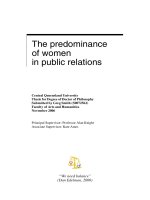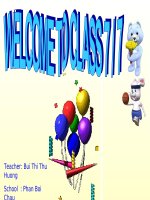Why She Plays The World of Women’s Basketball pdf
Bạn đang xem bản rút gọn của tài liệu. Xem và tải ngay bản đầy đủ của tài liệu tại đây (557.02 KB, 217 trang )
Why She Plays
The World of Women’s Basketball
Christine A. Baker Foreword by Becky Hammon
university of nebraska press
•
lincoln and london
© 2008 by Christine A. Baker
Foreword © 2008 by the
Board of Regents of the University
of Nebraska. All rights reserved
Manufactured in the United States
of America
Acknowledgments for previously
published material appear on page
xvi, which constitutes an
extension of the copyright page.
Library of Congress
Cataloging-in-Publication Data
Baker, Christine A.
Why she plays: the world of
women’s basketball / Christine A.
Baker; foreword by Becky Hammon.
p. cm.
Includes bibliographical references.
isbn 978-0-8032-1633-4
(pbk.: alk. paper)
1. Basketball for women — United
States — History. 2. Women basket-
ball players — United States — Biogra-
phy. 3. Basketball players — United
States — Biography. [1. Basketball for
women — History.] I. Title.
gv886.b29 2008
796.323Ј8 — dc22
2008027794
Set in Swift EF by Bob Reitz.
Designed by A. Shahan.
For the players.
When there is turmoil and questions
here, I fi nd silence.
When there is pain and wonder
here, I fi nd solitude.
When there is joy
here, I fi nd space.
Just one simple rim
out in nowhere
up in the clouds
in a quiet gym
a ’lil slice of beauty,
doesn’t have to be pristine
with nets beautifying the edge
doesn’t have to have lights and fans
surrounding the post
just give me a rim and there I’ll be
anywhere, any place
a place to be . . . me
the most.
It’s a simple thing,
just put the ball in the rim
the movement, the dance
believe and it goes in,
miss and try again
win, lose, enjoy
life.
That’s why I play.
Jacquie Shackelford
Why I Play
Foreword xi
Acknowledgments xv
Introduction: Why She Plays 1
part one youth basketball
1 Heck Yeah, I’m a Tomboy! 9
2 The Fun Factor 16
part two high-school basketball
3 You Can’t Measure Heart 33
4 The Crème of the Crop 42
Contents
part three college basketball
5 Three Divisions, One Association 55
6 Conradt, Goestenkors, and the
Pursuit of Perfection 65
7 The Approach of a Coach 75
8 A Dance Is Still a Dance 89
part four the wnba
9 Over Ten Years and Going Strong
in the wnba 99
10 The Superstars and the “Special”
Treatment 112
part five usa basketball
11 The United States versus the
Rest of the World 125
12 The Best in the World 131
part six media coverage and
women’s basketball
13 The Slippery Slope of Gender
Politics 147
14 Unique but Alike 158
15 Her Place of Peace 170
Epilogue: Building the Perfect
Player 181
Appendix A: High School
Participation by State 187
Appendix B: The Structure of
USA Basketball 189
Notes 193
Suggested Reading 197
xi
L
istening to howling coyotes and sitting underneath
the big sky and millions of stars were things I did of-
ten growing up in South Dakota. I remember admir-
ing the works of an awesome Creator, not realizing
what plans He had for my life. It was diffi cult for me to compre-
hend how all those millions of stars were hung.
At night after the fl oodlights were turned off on our con-
crete basketball court and my brother and father had gone in
the house, I would routinely stand out there on the darkened
basketball court, dreaming. Often I would let my thoughts run
wild and imagine hitting game winners, buzzer beaters, circus
shots, and nailing daggers from twenty-fi ve feet out. Imagina-
tion aside, I could not foresee how my life and career would con-
nect in the world of women’s basketball.
Foreword Becky Hammon
xii foreword
Growing up in South Dakota, I was shielded from the recruit-
ing craziness that now accompanies any girl who is a great high-
school basketball player. I have considered that a blessing and
always will. It’s one of the most basic and pure beliefs about life
in America: No handouts, just good ole fashioned hard work!
America is about opportunities. If there is (and I believe there
is) an American dream for a women’s basketball player, I’m liv-
ing proof of that dream come true. All I asked for was a fair op-
portunity, and I received it.
I do believe that any girl from any state, at any age, who
picks up a basketball and has a dream, does so because it is fun.
Dreams unify us and anchor our hearts together. Everyone may
have dreams, but few chase them, and even fewer are blessed to
live them.
For me that dreaming was fun. The countless hours I spent
alone in the gym were fun. On that court I developed my pas-
sion and love for the game of basketball along with my desire
to improve myself each and every day. That’s the reason why I
played and fell in love with this beautiful game.
I play this game for many reasons now, not simply because I
love it. I play it to inspire the 99 percent of people who are told
they aren’t good enough, tall enough, or didn’t come from the
“right program.” I play it because I love giving a high-fi ve to a
little girl or boy who will never forget that moment and won’t
wash their hands for the next week. I play because I want to give
you that precise moment that made your heart skip a beat and
made you leap out of your seat. I play because I want to see you
scratch your head and wonder how in the heck I made that shot
into the basket. I play because of the bigger picture! I play be-
cause every time I walk out onto the court I have the opportuni-
ty to blaze a trail through the minds of men, women, boys, and
girls and show by example that we should judge an athlete not
by the contour of their physique but by the character by which
they compete. I play to honor those women who came before
me who blazed a trail for me to have this singular opportunity.
I play because I love destroying every stereotype, every cultur-
al and gender barrier that our society argues doesn’t exist any-
more. I play so that every mother, sister, daughter, or niece can
foreword xiii
walk into any job interview or situation in life and be given a
fair opportunity. I play because every female and male needs to
see and understand what a confi dent, informed, inspired, and
qualifi ed woman can do when she puts her mind to something.
I play to inspire you to dream bigger than you think you can and
to climb higher than what you’ve been told is safe. I play bas-
ketball because it reminds me that no matter what people say I
can’t do, God says I can.
If all these reasons were taken away and there were no more
dreams to be dreamed, no more minds to be opened, or people
to be entertained and inspired, I’d still step out onto my old
basketball court in South Dakota. I’d play until it was dark out,
turn on the fl oodlights, and play some more. I’d play just be-
cause it’s fun, and the court is where I love to be.
xv
Acknowledgments
W
riting a book about basketball is nearly impos-
sible without accessing and utilizing a vari-
ety of statistics. In many cases these statistics
help paint the picture of a particular player,
coach, or program. Please note that the statistics given through-
out this text were current as of June 2007.
I would like to thank the many people who helped me with
this project: authors Paul Krafi n and Catherine Whitney for their
generosity, faith, and stubborn insistence that this story was
worth telling; Clay Kallam at Full Court Press for his knowledge of
the wnba and willingness to show me the ropes; Becky Hammon
for graciously taking the time to share her thoughts and time;
special thanks to the wnba, ncaa, Women’s Sports Foundation,
and National Federation of State High School Associations for
xvi acknowledgments
sharing a wealth of information; Caroline Williams from USA
Basketball and Ron Howard from the wnba for their assistance
and patience; Val Ackerman and Donna Lopiano for their time;
Christopher Dougherty for coming through in the clutch; Dr. In-
dira Karamcheti from Wesleyan University; special thanks to all
the players and coaches who generously donated their time and
thoughts to help make this book real; my fellow masterminds
for their unwavering support and inspiration; Dara Onofrio for
being my friend, angel, and toughest critic; and fi nally to my
parents and grandparents—the four corners of my world.
Portions of this book originally appeared, often in different
form, as the following:
“Life with the Liberty: A Bittersweet Journey: What Might Have Been,
What Might Be,” Full Court Press, June 15, 2005, l
court.com. Reprinted courtesy of Full Court Press.
“Life with the Liberty: Dreams Battle with Reality: Basketball Goes
One-on-One with Life,” Full Court Press, August 22, 2005, http://
www.fullcourt.com. Reprinted courtesy of Full Court Press.
“Place of Peace,” Confl uence: The Journal of Graduate Liberal Studies 12,
no. 2 (Spring 2007): 50–57.
“Ticha and ’Kesha Tell All: Key Players from the wnba’s Best Teams
Are Hungry for a Title,” Full Court Press, September 1, 2005, http://
www.fullcourt.com. Reprinted courtesy of Full Court Press.
“You Can’t Measure Heart,” Got Game Magazine, Summer 2005, 16.
Why She Plays
Sports do not build character. They reveal it. haywood hale broun
1
O
ne Friday night in July 2005, I walked out of the
tunnel and onto the fl oor of Madison Square Gar-
den moments before the New York Liberty basket-
ball team did the same. I was aware of the lights be-
hind me fl ipping on to illuminate the way for the players and
the television cameras. I saw the electrical wires crisscrossing
down the tunnel and underneath the hardwood fl oor. Only steps
ahead of the team, I watched the fans look beyond me to the
players they had paid to see. There was fanfare. There was noise,
but it was not for me and it never will be. I am like a ghost for-
ever hovering at the edges of the tunnel, riding the shadows of
the players, trying to grasp the ball as it slips just out of reach
of my fi ngertips.
Over 99 percent of all basketball players never have the oppor-
Introduction Why She Plays
2 introduction
tunity to play professionally, and I am one of the majority. Nev-
ertheless, since my father bought me my fi rst basketball at the
age of six, I dreamed of being a superstar. Twenty-eight years
later, not much has changed. Some nights when sleep eludes
me, I hear the sold-out arena chant my name, “Bak-er, Bak-er.”
The voices collectively urge me toward that sacred place of glo-
ry I still vividly envision.
Sadly the reality is that a sold-out arena will never chant
my name. An Olympic gold medal will never be gently placed
over my bowed head. Not every one of us is chosen for Olym-
pic glory. Legions of quiet superstars play because we want to.
We work against the odds of height or build or natural abili-
ty because we want to better ourselves, because we have a pro-
found love of a game. We have, each one of us, those moments
to treasure after practice in the empty gym. Those hours after
dark in the playgrounds and backyards across America are ours
and ours alone.
I might never be a professional basketball player, but the
court will forever be my home. Basketball is in my blood. It’s in
my heart. I play because I love the sound of a leather ball slip-
ping elusively through a chain net. I love the cracks in a black-
top court where the weeds poke through. I love the sound sneak-
ers make on a shiny indoor court. I love the competition and
the camaraderie. That’s why I play. Why do you?
My father gave me my fi rst basketball and hoop in the summer
of 1980 when I was six years old. I recall the orange basketball
nestled among countless stuffed animals on my bed, waiting,
pleading for me to pick it up and make it a part of me. I was
born an only child in rural Connecticut, but when I saw that
ball, I found my twin, my parallel soul. It was instantaneous, a
connection so powerful that to this day, I marvel at its intensi-
ty and longevity.
It didn’t take me long to get hooked. I watched basketball on
television well past my bedtime. I slept with the ball, walked
around the neighborhood with the ball, did everything with
that ball. Early on, my tutors were Larry Bird, Magic Johnson,
and Julius Erving. It was absolute enchantment to watch Dr. J
introduction 3
hit a swinging, graceful jump hook on television, but it was
pure bliss to practice hook shots and fadeaway jumpers in my
driveway until well past dark. I believed then with every fi ber
of my being that I was meant to play basketball — nothing more
and nothing less.
I vividly recall watching the 1984 nba Finals with my mom
and dad in our family room on a big black Naugahyde couch.
My beloved Boston Celtics, the blue-collar team made up of Lar-
ry Bird, Robert Parish, Danny Ainge, Dennis Johnson, and Kevin
McHale against the Hollywood glitter of the Lost Angeles Lakers,
led by Magic Johnson, along with Kareem Abdul-Jabbar, James
Worthy, Byron Scott, and the rough Kurt Rambis. It was patience
versus running, East versus West, tradition versus glamour. It
was a brutal series, one that caused Lakers’ head coach Pat Ri-
ley to lose his legendary cool more than once. The games began
late, and I was up until well past midnight clutching a pillow to
my face as the action on the court became too intense.
The ’84 Celtics weren’t physically imposing or fl ashy. They
were smart and relentless, and Larry Bird epitomized this per-
sona. The skinny red head from French Lick, Indiana, did things
with a basketball that made the hair on my arms stand on end.
He wasn’t a vocal leader, but he led his team by example, and
they followed. Hell, I followed, and I was only an eleven-year-old
girl. Larry Bird led that team not with an outspoken demean-
or but with his play. He let his game do the talking. His team-
mates, and I, listened well.
For a girl in the early 1980s, it just wasn’t that simple. While
there were plenty of winter basketball leagues and summer bas-
ketball camps, they were for boys, not girls. I played on boys bas-
ketball teams with Lions Club in Haddam, Connecticut. Because
I was one of the best players in the league, the other boys didn’t
make much of the fact that I played. I recall only one other girl
who played with me. We were never on the same team, but I re-
member she was good. She was tall and wore long, colorful rib-
bons attached to her barrettes.
It wasn’t until 1983 that an all-girls league began in my home-
town. When the girls’ league began, she switched over, as did
I. We were the only two girls who had been good enough to
4 introduction
hold our own with the boys, so whenever we faced one another,
we were both extremely motivated. On those rare occasions we
stared one another down at the start of the game in a way that
would make Mohammad Ali proud. Barrettes or no barrettes,
ribbons or no ribbons, we were primed for battle. I don’t recall
who outplayed the other in those early games, but I do remem-
ber the level of intensity and the fi erce competitiveness we both
brought to the court. I often wonder what became of her and if
basketball is as much a part of her soul as it is mine.
When I was fi fteen years old, in my diary I swore with the so-
lemnity of a subpoenaed witness, with a tiny pin prick of blood
to mark the spot, that I would never forget the sound of a chain
net in the school playground or the way my hands had become
molded to the round softness of a leather ball. I promised that
I would play basketball forever. I promised all this because I
thought I should make it offi cial on the off chance things would
change down the road.
That promise, however innocent and well intentioned, marked
a turning point in my relationship to the game. By acknowledg-
ing my deep connection to the game, I twisted my relationship
with it and forced upon it a value better left unmentioned. I im-
posed myself upon the game without its permission, and ulti-
mately, I burned out. Through high school and college I felt the
weight of its burden over its beauty, its struggle more than its
solace. I grew to fear my obsession with improving.
When I graduated from college in 1995, I could no longer ar-
ticulate my love for the game. Instead I was afraid it had swal-
lowed me up, afraid I would never be good at anything else.
As a result I ran as far from the game of basketball as I could. I
worked on a career in publications management with the same
intensity I had once worked on my jump shot. Simply I was de-
termined to succeed without a ball in my hands.
One morning in February of 2005 I woke up to the cold
gray sunrise and dressed for work. Before I left for the offi ce, I
looked at myself in the full-length mirror. Neatly dressed with
dark slacks and a blue silk turtleneck, my blond hair pulled up
off my face, I no longer recognized the person staring back at
me. I stood, refl ected in that mirror, alone — the court and the
introduction 5
backboards were gone. The ball racks, sneakers, and water bot-
tles — gone too. In their place was a briefcase fi lled with proofs
and schedules, a Palm Pilot with names and appointments I
could barely keep track of, and a cell phone with fi ve unheard
messages. I had allowed myself to walk away from the game I
loved. I had misled myself, and the hurt fi nally hit me. As I in-
haled, I felt the air rattle around my hollow insides, and I real-
ized that like the Grinch, my heart had grown three sizes too
small.
Determined to make a change, I walked away from a career
as a publications director. I walked away from routine and di-
rect deposit, good benefi ts and stability that would have easi-
ly led to a nice house at the end of a cul-de-sac, to fi nd my way
back to the game of basketball. I knew it was a leap of faith, but
quite simply I wanted to go home.
Home became a pressroom in the underbelly of an arena.
Home is listening to starting lineups and transcribing inter-
views. Home is writing for little or no money about the game
I love. I’m not surprised anymore when sports editors tell me
that my writing is good but that they can’t afford to pay some-
one only to cover the wnba.
I learned that the business of basketball is entertainment. I
learned how diffi cult it is for women’s sports to compete in the
global marketplace. I talked with players at the highest level
who struggle to maintain their individuality in a league that
treats players as commodities (just as in any professional sports
league), as products to be bought and sold in hopes of creating
the magic formula that will win a championship.
Sometimes I fear that I’ve turned cynical about the world of
women’s basketball. Whenever that feeling becomes overwhelm-
ing, I just close my eyes and think back to Teresa Weatherspoon
with her fi sts raised high at the Garden after she hit that amaz-
ing fi fty-foot buzzer beater on September 4, 1999, in Game 2 of
the wnba fi nals against Houston. I think back to the high-school
team I coach and the joy we experienced when one of my play-
ers hit a similar shot in a playoff game just last season.
When the business overwhelms me, I recall that unmistak-
able gym smell of sweat and hardwood and movement. Before I
6 introduction
know it, I can hear the game again — sneakers squeaking on the
hardwood, bodies fl ying down the court, players calling picks — I
can feel the precise choreography and that gossamer-thin con-
nection between players and ball, and then it’s all ok, and it’s
all worth it, lousy paycheck and all.
Acclaimed sports writer Steve Wilstein once said, “Nobody
cares how much effort it takes or what you have to do to get the
story in, just as long as you do.” While that statement is true,
there are still some of us out there who write about the sport
not just to turn in a story but also to feel connected once more
to the game we love so much.









